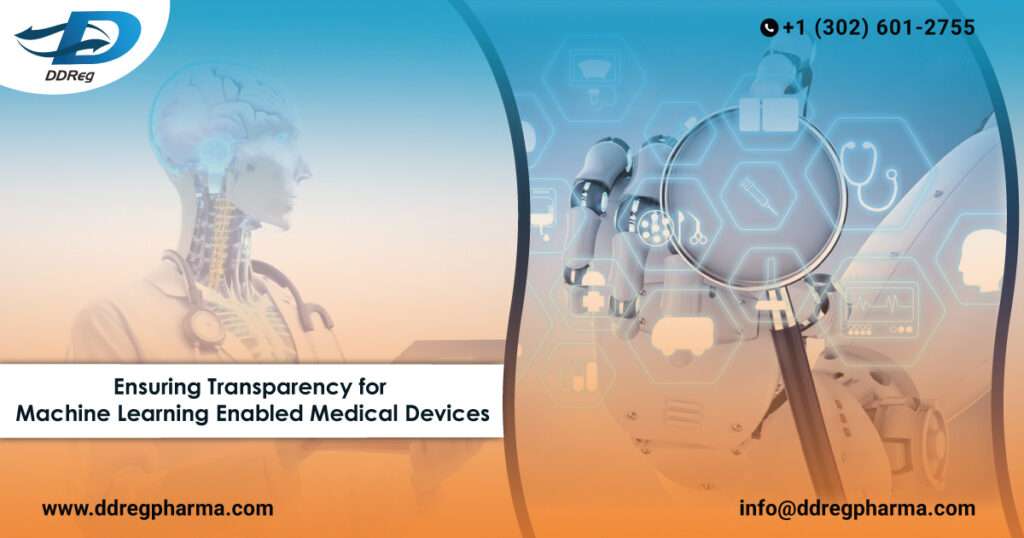Transparency in Machine Learning-Enabled Medical Devices (MLMDs) refers to the degree to which relevant information about a device—such as its intended use, the development process, performance, and logic—is clearly communicated to stakeholders. Why is this important? To help the development of safe, effective, and high-quality AI/ML learning technologies. These may learn from real-world data and even improve the performance of devices- taking medical devices and healthcare to the next level in a more harmonized manner.
Guidance Principles for Good Machine Learning Practice
In 2021, the US FDA, Health Canada, and UK MHRA identified 10 principles for good machine learning practice (GMLP), to address the unique characteristics of these devices and support their development. Though these principles were more focused on enhancing the transparency of MLMDs(Machine Learning-Enabled Medical Devices), they may also be applied to devices in general. The 10 principles identified by the FDA, Health Canada, and UK MHRA are as follows:
- Multi-Disciplinary Expertise Is Leveraged Throughout the Total Product Lifecycle
- Good Software Engineering and Security Practices are Implemented
- Clinical Study Participants and Data Sets and Representative of the Intended Patient Population
- Training Data Sets Are Independent of Test Sets
- Selective References Datasets Are Based Upon Best Available Methods
- Model Design is Tailored to the Available Data and Reflects the Intended Use of the Device
- Focus is Placed on the Performance of the Human-AI Team
- Testing Demonstrates Device Performance During Clinical Relevant Conditions
- Users and Provided Clear, Essential Information
- Deployed Models Are Monitored for Performance and Re-training Risks Are Managed
Ensuring Transparency for Machine Learning-Enabled Medical Devices
In June 2024, the United States Food and Drug Administration (FDA), in collaboration with Health Canada and the United Kingdom’s Medicines and Healthcare products Regulatory Agency (MHRA), released guiding principles to enhance transparency in machine learning-enabled medical devices (MLMDs). These principles build on the previously established Good Machine Learning Practice (GMLP) principles, emphasizing the need for clear and essential information to ensure the performance and safety of human-AI teams.
Human-Centered Design
A crucial aspect of promoting transparency in MLMDs is adopting a human-centred design approach. This iterative process addresses the complete user experience and involves relevant parties throughout the design and development stages. Human-centred design helps in developing highly transparent MLMDs, validating transparency, and ensuring that users have access to all the necessary device-related information.
The guiding principles for MLMD transparency address the following key questions:
- Who: Relevant audiences include healthcare professionals, patients, caregivers, support staff, administrators, payors, and the governing bodies. These parties use, receive healthcare with, or make decisions about the device.
- Why: Transparency is vital for patient-centred care and the safety and effectiveness of MLMDs. Transparent information helps in identifying and evaluating device risks and benefits, ensuring safe use, and promoting health equity by identifying and addressing biases. Consistent and clear information builds trust and encourages the adoption of beneficial technologies.
- What: The relevant information varies depending on the MLMD’s risks, benefits, and user needs. Essential information includes the device’s medical purpose, diseases or conditions it addresses, intended users, use environments, target populations, performance details, and risk management activities. It is also important to explain the device’s logic, development process, and any known limitations or biases.
- Where: Information should be accessible through the user interface, which includes training materials, physical controls, display elements, packaging, pharma labeling, and alarms. The software user interface should be optimized to be responsive, personalized, adaptive, and reciprocal, addressing user needs through various modalities like audio, video, text, alerts, and diagrams.
- When: Transparency should be maintained throughout the total product’s lifecycle. Information is needed when deciding to acquire or use the device, and timely notifications should be provided for updates or new information. Targeted information should be available at specific workflow stages or triggers.
- How: Effective communication requires a holistic understanding of users, environments, and workflows. Applying human-centered design principles ensures that the information provided is accessible, usable, and relevant. Information should be detailed appropriately for the intended audience, arranged to support decision-making, and presented in plain or technical language as needed.
Benefits of Transparency
Transparent MLMDs offer numerous benefits, including improved fluency and efficiency in device use, increased trust and confidence in the technology, and greater adoption and access to beneficial innovations. Transparency also supports the maintenance and continuous safety of devices, helps detect and investigate errors or performance issues, and promotes health equity by identifying biases and ensuring justifiable system outputs.
Conclusion
The FDA, Health Canada, and MHRA emphasize that transparency is a key practice for all medical devices, not just MLMDs. It is intended that the principles will support the safety, effectiveness, and equity of use of MLMDs through promoting transparency throughout the device’s life cycle. In such a fast-growing field, these guiding principles are very important, together with the consensus standards devised, implemented, and further developed collaboratively.
The agencies welcome continued feedback and engagement with these efforts via the FDA public docket (FDA-2019-N-1185) at Regulations.gov and through email contact. These principles consider how best to advance good transparency practices in developing and using these MLMDs so that these technologies serve all stakeholders involved in healthcare delivery.
With experience of over 120 regulatory agencies and subject matter expertise, DDReg is the go-to partner for pharmaceutical regulatory and pharmacovigilance services. Read more from the experts about Artificial Intelligence: Machine Learning and Simulations for Clinical Trials.

